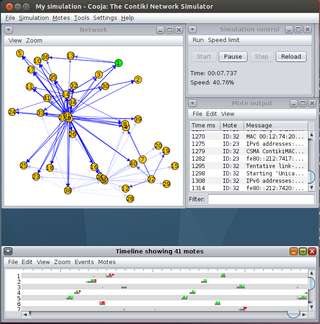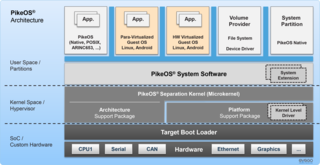
An embedded system is a computer system—a combination of a computer processor, computer memory, and input/output peripheral devices—that has a dedicated function within a larger mechanical or electronic system. It is embedded as part of a complete device often including electrical or electronic hardware and mechanical parts. Because an embedded system typically controls physical operations of the machine that it is embedded within, it often has real-time computing constraints. Embedded systems control many devices in common use. In 2009, it was estimated that ninety-eight percent of all microprocessors manufactured were used in embedded systems.

QNX is a commercial Unix-like real-time operating system, aimed primarily at the embedded systems market. QNX was one of the first commercially successful microkernel operating systems.
RTLinux is a hard realtime real-time operating system (RTOS) microkernel that runs the entire Linux operating system as a fully preemptive process. The hard real-time property makes it possible to control robots, data acquisition systems, manufacturing plants, and other time-sensitive instruments and machines from RTLinux applications. The design was patented. Despite the similar name, it is not related to the Real-Time Linux project of the Linux Foundation.
In computing, Quark is an operating system kernel used in MorphOS. It is a microkernel designed to run fully virtualized computers, called boxes. As of 2020, only one box is available, the ABox, that lets users run extant AmigaOS software compiled for Motorola 68000 series and PowerPC central processing units (CPUs).

Contiki is an operating system for networked, memory-constrained systems with a focus on low-power wireless Internet of Things (IoT) devices. Contiki is used for systems for street lighting, sound monitoring for smart cities, radiation monitoring and alarms. It is open-source software released under the BSD-3-Clause license.
Nucleus RTOS is a real-time operating system (RTOS) produced by the Embedded Software Division of Mentor Graphics, a Siemens Business, supporting 32- and 64-bit embedded system platforms. The operating system (OS) is designed for real-time embedded systems for medical, industrial, consumer, aerospace, and Internet of things (IoT) uses. Nucleus was released first in 1993. The latest version is 3.x, and includes features such as power management, process model, 64-bit support, safety certification, and support for heterogeneous computing multi-core system on a chip (SOCs) processors.

The Blackfin is a family of 16-/32-bit microprocessors developed, manufactured and marketed by Analog Devices. The processors have built-in, fixed-point digital signal processor (DSP) functionality supplied by 16-bit multiply–accumulates (MACs), accompanied on-chip by a microcontroller. It was designed for a unified low-power processor architecture that can run operating systems while simultaneously handling complex numeric tasks such as real-time H.264 video encoding.
Micro-Controller Operating Systems is a real-time operating system (RTOS) designed by Jean J. Labrosse in 1991. It is a priority-based preemptive real-time kernel for microprocessors, written mostly in the programming language C. It is intended for use in embedded systems.

FreeRTOS is a real-time operating system kernel for embedded devices that has been ported to 35 microcontroller platforms. It is distributed under the MIT License.
Azure RTOS ThreadX is a highly deterministic, embedded real-time operating system (RTOS) programmed mostly in the language C.
EKA2 is the second-generation Symbian platform real-time operating system kernel, which originated in the earlier operating system EPOC.

The Texas Instruments DaVinci is a family of system on a chip processors that are primarily used in embedded video and vision applications. Many processors in the family combine a DSP core based on the TMS320 C6000 VLIW DSP family and an ARM CPU core into a single system on chip. By using both a general-purpose processor and a DSP, the control and media portions can both be executed by separate processors.

PikeOS is a commercial, hard real-time operating system (RTOS) that offers a separation kernel based hypervisor with multiple logical partition types for many other operating systems (OS), each called a GuestOS, and applications. It enables users to build certifiable smart devices for the Internet of things (IoT) according to the high quality, safety and security standards of different industries. For safety and security, critical real-time applications on controller-based systems without memory management unit (MMU) but with memory protection unit (MPU) PikeOS for MPU is available.

DSP/BIOS Link or DSPLINK is an interprocessor or inter-process communication (IPC) scheme to pass messages and data in multiprocessing systems. In the case of the DaVinci digital signal processor (DSP) family from Texas Instruments, this scheme allows passing messages and data between an ARM client and a DSP server. DSPLINK can be used to implement a layer of software abstraction called a remote procedure call (RPC) that allows a remote function on the DSP to appear as local function calls in the ARM application code. The Codec Engine IPC communication layer is implemented using a RPC call scheme built on DSP/BIOS LINK.

ChibiOS/RT is a compact and fast real-time operating system supporting multiple architectures and released under a mix of the GNU General Public License version 3 (GPL3) and the Apache License 2.0. It is developed by Giovanni Di Sirio.
BeRTOS is a real-time operating system designed for embedded systems.

TenAsys is a privately owned company providing real-time software and services based on the x86 Intel Architecture and Microsoft Windows operating system.
MQX is a real-time operating system (RTOS) developed by Precise Software Technologies, Inc., and currently sold by Synopsys, Embedded Access, Inc., and NXP Semiconductors.

QP is a family of open source real-time embedded frameworks (RTEFs) and runtime environments based on active objects (actors) and hierarchical state machines. The QP family consists of the lightweight QP/C and QP/C++ frameworks, written in C (C99) and C++ (C++11), respectively.

T-Kernel is an open source real-time operating system (RTOS) designed for 32-bit microcontrollers. It is standardized by the T-Engine Forum, which distributes it under a T-License agreement. There is also a corresponding Micro T-Kernel (μT-Kernel) implementation designed for embedded systems with 16-bit or 8-bit microcontrollers.












